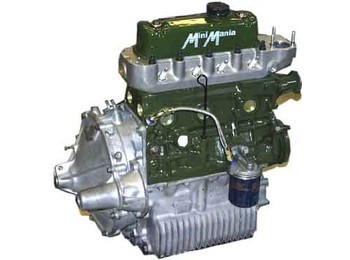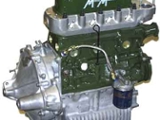
Classic Mini Engines: a Basic Overview Including Metro
Other articles you might be interested in:
- Gude: how to identify your Classic Mini Engine - click here
- Classic Mini Identification: a comprehensive index of the years and models of the Classic Mini - click here
- Guide: how to identify your Classic Mini by VIN or Chassis number - click here
The widespread and prolific fitment of Metro engines into Classic Minis — usually those endowed as standard with small-bore (850/998/1098cc) engines — practiced in the U.K. has been spreading to many other countries worldwide. So it's not surprising that the most commonly asked question has also become more prolific concerning the fitment of said engine - apart from actually how to manage the transplant and the differences in the installations, covered in articles relevant article on this site - is just which type of engine the individual concerned has bought or what they already have fitted to their car and is it worth keeping or junking. One initial question I pose often draws a pregnant silence whilst said inquirer scrambles their brains trying to find an answer for. Following that protracted pause, 'I dunno' is the usual answer. I then have to get into a lengthy explanation as to how to determine what said engine is. To circumvent as many of these instances as possible, and endow all and sundry with the wherewithal to do the detective work for themselves, I have here produced the most comprehensive listing of engine identification data for the Metro A+ engines I could unearth given a reasonable amount of time. There should be enough here for everybody to make a very fair identification of what they have and what they're looking for. The number you will need is that stamped into an aluminum plate riveted to the engine block just below the thermostat housing.
A word of warning — whilst the data given here is as accurate and complete as could be made without 6 months-worth of hermit-like investigation, there are bound to be oddities. Austin/Morris, British Leyland/Austin Rover Group/Rover were never dedicated at keeping 100% correct records, particularly post-1970 - that's why Heritage really struggles with trying to identify cars manufactured after 1969. The Metro data - or lack of it - proves the point. It's nothing like as comprehensive as the Mini stuff.
Whilst most of the engines do not really give a whole lot of difference in performance, the one outstanding version is the MG Metro engine. Where the majority of the variously similar power plants put out around 63-65bhp, the MG Metro achieves a more spirited 70-74bhp. This is due to a higher compression ratio (10 -1), larger inlet valve (35.7mm instead of 33.3mm), and - mainly - a more sporty camshaft with half-decent induction and exhaust systems. The inlet manifold being a reasonably good flowing, water heated aluminum example. Rover finally got the hint having witnessed the prolific after-market fitment or such an item to Minis in epic proportions for years. The exhaust manifold is a cast iron 'LCB' style with a pair of exhaust downpipes instead of the more common single item and works very efficiently. A bonus of this over the more common after-market steel-tubed LCBs is that it is much quieter by dint of absorbing more exhaust 'noise'. Coupled to a pair of Maniflow tubular steel downpipes it is very nearly as efficient as a full tubular steel manifold. The cylinder head is more along the lines of the old Cooper S -spec and in fact flows slightly more air than it's predecessor, the camshaft being the sportiest fitted to any production A-series engine. It uses the inlet profile and timing of the original 997 Cooper cam and the exhaust specification of the old Leyland Special Tuning '731' fast road cam.
- 1st prefix group identifies engine capacity -
- 85 = 850cc (mainly used in export only models)
- 99 = 998cc
- 12 = 1275cc
- 1st prefix letter identifies engine orientation -
- H = Transverse
- 2nd prefix group identifies gearbox, ancillary and specific engine type -
- - Prefix number identifies general engine installation details (i.e. '907')
- - Prefix letter identifies emissions equipment type (i.e. 'P')
- 3rd prefix group identifies compression ratio and serial number prefix letter denotes compression ratio -
- H = High compression
- L = Low compression
Prefix number is engine serial number (i.e. 101, 102, etc.)
2nd Prefix Number Combination References
- 897 - Yd + Bf + Hm + Zj +Sk
- 898 - Yd + Bf + Hm + Zj + Tj
- 907 - Yd + Bf + Hm + Sk
- 908 - Yd + Bf + Hm + Tj
- 929 - Yd + Bf + Hm + Dn + Sk
- 951 - Yd + Bf + Hm + Zj + Dn + Sk
- 955 - Yd + Bf + Hm + Nl + Sk
- 958 - Yd + Bf + Hm + Nn + Sk
- 959 - Gd + Bf + Hm + Fp + Sk
- 962 - Yd + Bf + Hm + Hf + Sk
- 963 - Yd + Bf + Hm + Hf + Zj + Sk
- 977 - Yd + Bf + Hm + Xc + Jn + Sk
- 978 - Yd + Bf + Hm + Xc + Dn + Sk
- 996 - Yd + Bf + Yn + Sk
- A02 - Yd + Bf + Hm + Nn + Sk
- A05 - Yd + Bf + Hm + Hf + Zj + Kp + Sk
- A06 - Yd + Bf + Hm + Kp + Sk
- A07 - Yd + Bf + Hm + Zj + Lp + Sk
- A08 - Yd + Bf + Hm + Lp + Sk
- A09 - Yd + Bf + Hm + Nl + Lp + Sk
- A47 - Yd + Bf + Hm + Vn + Sk
2nd Prefix Letter Reference Details
- Bf - Alternator with negative earth
- Dn - Base line engine with single outlet exhaust manifold
- Fp - Metro high performance derivative (meant to identify high compression, sportier than original and initial standard cam and can include MG Metro specification derivatives)
- Gp - High pressure electric fuel pump (therefore MG Metro Turbo)
- Hf - 1st alternative compression ratio (should be 9.7-1CR as used in early pre 1983 range)
- Hm - LC8 design variant (probably means the 'Low Compression' A+ derivative of the A-series engine - as in '&' denotes a Mini engine)
- Jn - 1980 requirements (probably closed circuit breathing and lean-running)
- Kp - 3.65 Final Drive fitted to gearbox
- Lp - 3.105 Final Drive fitted to gearbox
- Nl - Hot climate specification (usually more conservative ignition advance curve in dizzy, different thermostat and different fuelling, i.e. carb needle)
- Nn - Alternative compression ratio (should be 9.75-1CR as used in post 1983 general range)
- Sk - Standard ratio gearbox with 3.44 Final Drive, inboard CV joints and rod change
- Tj - Automatic gearbox fitment
- Vr - Post Office spec - i.e. low compression and low final drive
- Yc - Police spec - i.e. high compression, probably MG cam and up-rated diff pin
- Yd - Mechanical fuel pump
- Yn - MG Metro design/specification variants (high CR, sportier CAM6648 cam, bigger inlet valve in head) also known to be fitted to LHD Van Den Plas
- Zj - Cold country spec (more advanced advance curve in dizzy, different thermostat and so on)
2nd Prefix Letter Data
- AA - Carburetter crankcase ventilation and intake air temperature control
- P - Carburetter crankcase and clean air package
EXAMPLE:
- 99H907PH101
- 99 - 998cc
- H - Transverse
- 907 - Yd + Bf + Hm + Sk
- Yd - Mechanical fuel pump
- Bf - Alternator with negative earth
- Hm - LC8 variant - A+ Metro engine
- Sk - Standard gearbox ratios with 3.44 final drive, inboard CV joints, rod change
- P - Carburetor crankcase and clean air package
- H - High compression
- 101 - Engine serial number









